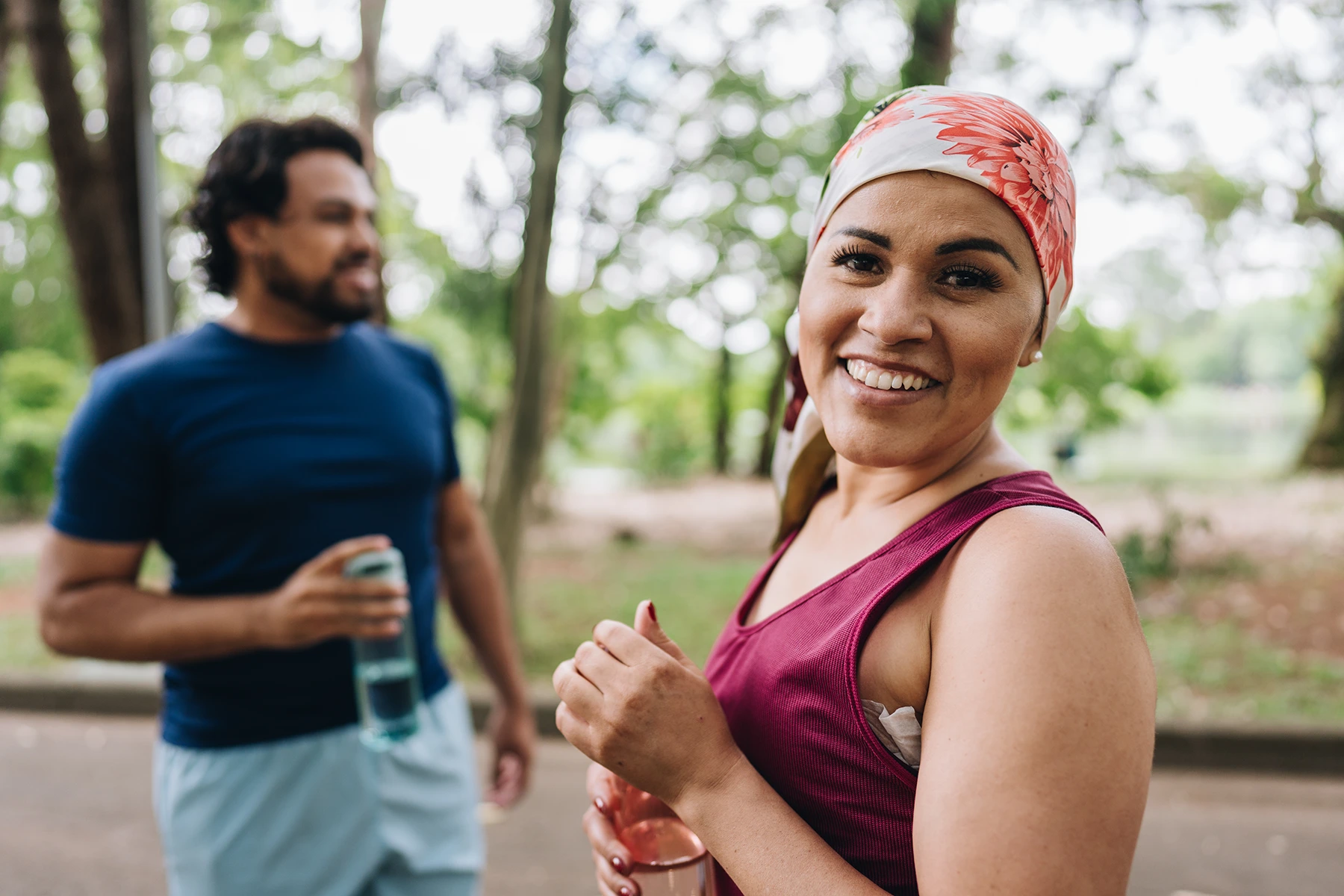How to Get Fit After (Even During) Cancer Treatment

Exercise to maintain and even build fitness during and after cancer treatment has been linked to significant benefits for cancer survivors’ health and well-being.
Based on a growing body of research, exercise not only helps people prevent cancer but can offer a better quality of life and health benefits during and long after a cancer diagnosis.
According to the National Cancer Institute (NCI), there is strong evidence, for example, that moderate-intensity aerobic or resistance exercise during and after cancer treatment can reduce anxiety, depressive symptoms and fatigue to help improve quality of life and physical function.
Cancer survivors who are physically active and meet national recommendations have fewer treat-related side effects, such as fatigue and cognitive impairment (also known as chemo brain). They tend to have better overall quality of life and live longer.
Believe in exercise and believe in yourself.
“Because of the many benefits, we not only recommend cancer survivors engage in regular exercise, but we make it a priority in programs that we offer, including Believe in You,” says Paola Rossi, M.D., M.S.Ed., clinical program director for lifestyle medicine at Sylvester Comprehensive Cancer Center, part of the University of Miami Miller School of Medicine.
Sylvester’s Believe in You program is a free four-month training program for cancer survivors and their caregivers. Its goal is to build a supportive community, help participants gain strength and improve their fitness. The program concludes with the Dolphins Cancer Challenge (DCC) each February, where participants can choose to join the DCC’s 5k walk or run, or 15-mile or longer bike rides.
In addition to planned walks/runs in local parks, supervised exercise classes and training education, Believe in You offers nutrition workshops. These include cooking classes by Dr. Rossi, who is certified in culinary medicine, and talks by Tracy Crane, Ph.D., RDN, director of Lifestyle Medicine, Digital Health and Cancer Prevention at Sylvester and Believe in You founder.
“Studies have shown that having a plant-based diet focused on fruits, vegetables, whole grains, eating lean protein, reducing added sugars and limiting red and processed meats has a big impact — not only on cancer prevention but also cancer survivorship. Just increasing fruit and vegetable intake has been shown to greatly reduce cancer mortality,” Dr. Crane says. “Combined, nutrition and exercise offer a powerful one-two punch in cancer survivors’ path to long-term health and wellness.”
Healthy eating and regular exercise can lead to a healthy body weight and increased energy, which can be handy when sticking to an exercise program. The American Cancer Society says simple adjustments can help, like eating beans and peas instead of meat for meals a few times weekly.
The science behind exercise is getting stronger.
In recent decades, the evidence showing the benefits of exercise for cancer survivors has grown.
“We now recommend and know a variety of exercises are beneficial, ranging from tai chi and yoga to strength and aerobic training,” Dr. Crane says.
Dr. Rossi says that studies now suggest that incorporating more vigorous exercise into a weekly routine can improve symptom management and quality of life. The amount (and intensity) of aerobic physical activity should be calibrated to a person’s fitness level and health. In general, the exercise recommendation for cancer survivors is:
- 150 to 300 minutes of moderate-intensity aerobic activity (like brisk walking)
- 75 to 100 minutes of vigorous aerobic activity (like running)
- an equivalent mix of those intensities each week
“Fatigue, which impacts up to 90% of cancer patients, is a good example,” Dr. Rossi says. While it’s counterintuitive to think about being active to improve fatigue, exercise is the best medicine to improve symptoms of fatigue, Dr. Rossi says.
Top 5 exercise do’s and don’ts for cancer survivors:
Dr. Rossi and Bryan Mejia, M.A., a prevention health coach at Sylvester, say more recent studies help clarify exercise do’s and don’ts for cancer survivors:
- Do moderate-intensity aerobic exercise, such as brisk walking, cycling or swimming (or water aerobics). A rule of thumb for measuring moderate intensity is that you can maintain a conversation but won’t be able to sing.
- Do incorporate resistance exercises two to three times a week using body weight, resistance bands, or light weights. Yes, weights. But start with low resistance and gradually progress based on tolerance and guidance from a health care provider. Mejia recommends squats, modified or regular pushups and planks, bicep curls, lateral band walks, seated rows and more.
- Don’t ignore the gentler but more effective exercises for flexibility and balance, such as stretching, yoga or tai chi.
- Do believe in the evidence that getting the recommended aerobic and strength training exercise helps decrease the risk of cancer coming back or new cancer developing. Exercise diminishes common symptoms during cancer survivorship, like depression and anxiety, and improves one’s spirit. “After workouts, there are a lot of ‘happy hormones’ released, like endorphins,” Dr. Rossi says. “As a result, exercise helps with fulfillment and feeling aligned with our bodies.”
- Do be true to yourself. Everybody is different. Listen to your body. Be sure to get plenty of fluids (eight to 10 glasses of water) and avoid exercising outdoors during the hottest times of the day.
Register for Believe in You today. Registration is open until 10/05/24.
The Believe in You program (online and in-person) runs from Sept. 26, 2024 to Feb. 25, 2025. For more information, email [email protected] or call (305) 243-5013.
Lisette Hilton is a contributor for Sylvester’s news service.
Tags: cancer prevention efforts, Dr. Paola Rossi, Dr. Tracy Crane, healthy lifestyle, Sylvester Comprehensive Cancer Center
